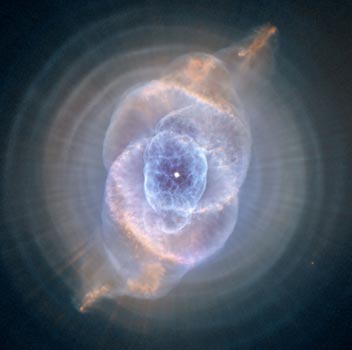 Cat's Eye Nebula (Hubble Space
Telescope)
Cat's Eye Nebula (Hubble Space
Telescope)All that we eat, drink, and breathe, the very atoms of our bodies and the earth we walk upon, were forged deep in the fires of massive stars which exploded in their death throes aeons ago. Such supernovae explode in a blinding flash of light which for a few seconds can outshine the total light output of their home galaxy. Supernovae — and the less spectacular but often beautiful planetary nebulae cast off by smaller dying stars such as our sun (see cover photo and p. 68) — seed the universe with elements vital to the creation of other stars and planets and ultimately of the lives upon them. But are these gifts of the stars the result only of blind nuclear processes or are they part of the circle of life within a compassionate living universe?
On February 24, 1987, a supernova explosion known as 1987A appeared in the Large Magellanic Cloud, one of the comparatively small "companion" galaxies of our own Milky Way. This was the brightest supernova to be seen since 1604, and even though the explosion occurred 170,000 light-years away, it could be seen by the naked eye on earth. Scientists have been monitoring this display of cosmic fireworks for almost twenty years and many of nature's secrets related to the death of stars and the dawn of life are slowly yielding to their patient observation.
Cat's Eye Nebula (Hubble Space Telescope)
One of the great questions of modern science has been the origin of the elements, the building blocks of the universe. Current theories hold that the cosmos began after a Big Bang with only the simplest hydrogen atoms. The only places we know that are hot enough to transform elements such as hydrogen into heavier ones, such as oxygen and carbon, are at the cores of stars, where the temperatures can reach many millions of degrees. As with 1987A, most massive stars become unstable at the end of their lives and explode in a sudden burst of energy that can propel as much as 90% of their material into space. Furthermore, during such explosions heavier elements such as gold, platinum, and uranium are formed and eventually recycled into new stars, planets, and even new human beings!
Dramatic pictures from the Hubble Space Telescope show fiery circular ring-clouds of superheated gas speeding away from the site of the central explosion at speeds approaching that of light. When this rapidly moving gas collides with existing galactic gas clouds, the energy produced can begin whirlpool motion which in turn creates new stars and solar systems. Further, the speeding atomic particles themselves form cosmic rays which, when they rain down on earth, may affect the genetic code of living things.
From the death of the great celestial entities we call stars springs new life in the marvelous economy of universal nature. But why speak of stars as living entities when astronomy understands them only as nuclear furnaces relentlessly following the dictates of physical laws? Theosophy presents the cosmos as a living organism composed throughout of beings in all various stages of spiritual growth and development. Thus the bright pinpoints of light in the night sky are the visible aspects of conscious celestial entities which we might call gods. These beings, from a human point of view, have vast responsibilities for the myriad of lesser entities who inhabit the solar systems we now know are spread throughout our, and presumably other, galaxies (to date, 169 planets have been found orbiting stars in other parts of our galaxy). For billions of years these star-gods give of their energies to support us lesser beings, and in death offer their very substance to build future generations of evolving entities, including humans, making us all quite literally "children of the stars."
What of the future of our own bright day-star? Strange as it may seem, in our galaxy the sun is a mid-sized to small star, though much larger than the majority of red or brown "dwarf" stars. Because of internal nuclear processes as the sun ages, it is theorized that in about seven billion years it will swell to encompass the distance of the earth's current orbit and become what astronomers call a red giant. In time its outer shell or atmosphere will explode outwards, sending its cast-off elements, particularly helium and nitrogen, into the depths of the Milky Way. Some of these elements will find their way into the massive interstellar gas clouds spread throughout the galaxy which give birth to new stars and planets. As one astronomer put it recently: "Calculations suggest the Sun's newly-minted nitrogen could endow roughly 100 million terrestrial planets with atmospheres like our own. Thus, even after it dies, the Sun, which now supports life on earth, may continue to do the same on other planets."*
*Ken Croswell, "Ready, set, boom!," Astronomy, September 2005, p. 45.
Seven billion years! That's a lot of time for us to learn the mysteries of the universe. Through countless incarnations of offering our own gifts to universal nature in daily life, perhaps one day we'll grow enough in spiritual stature to join the star-gods in their compassionate work.